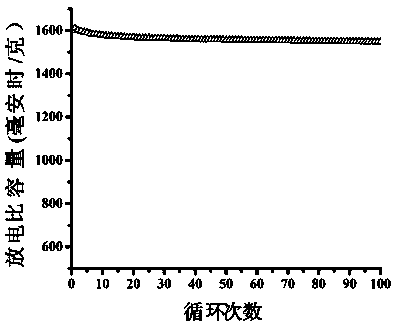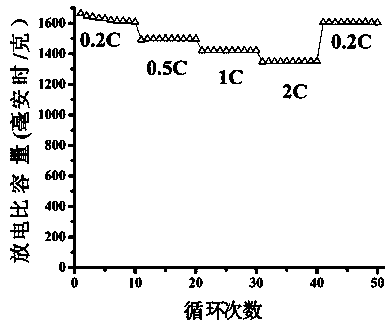Self-supporting functional interlayer for lithium sulfur battery and preparation method of self-supporting functional interlayer
A self-supporting film and copper sulfide technology, applied in the field of material chemistry, can solve the problems of low coulombic efficiency of sulfur cathode, low conductivity of sulfur and lithium sulfide, and damage to the electrode structure, so as to achieve improved cycle stability, excellent rate performance, and specific The effect of large surface area
- Summary
- Abstract
- Description
- Claims
- Application Information
AI Technical Summary
Problems solved by technology
Method used
Image
Examples
Embodiment 1
[0026] (1) Preparation of nitrogen-doped MXene:
[0027] Immerse the ground MAX phase ceramic powder in HF solution with a mass concentration of 40%, the mass ratio of ceramic powder to HF solution is 1:20, heat up to 60°C, stir magnetically for 18 hours, then centrifuge to obtain the product, and use deionized water Wash until neutral, and dry in an oven at 70°C for 18 hours to obtain MXene. The obtained MXene was placed in a tube furnace, heated to 400°C under an argon atmosphere, passed through ammonia gas, and kept for 30 minutes, then the ammonia gas was turned off, and cooled with the furnace under an argon atmosphere to obtain nitrogen-doped MXene. Wherein the MAX phase ceramic is Ti 3 AlC 2 . Get MXene material as Ti 3 C 2 T x .
[0028] (2) Preparation of nitrogen-doped MXene composite copper sulfide self-supporting film:
[0029] 0.8 g of copper sulfate, 0.8 g of thioacetamide and 1.5 g of the nitrogen-doped MXene prepared in step (1) were dissolved in 80 mL ...
Embodiment 2
[0033] (1) Preparation of nitrogen-doped MXene:
[0034]Immerse the ground MAX phase ceramic powder in HF solution with a mass fraction of 30%, the mass ratio of ceramic powder to HF solution is 1:30, heat up to 50°C, stir magnetically for 12 hours, then centrifuge to obtain the product, and use deionized water Wash until neutral, and dry in an oven at 60°C for 12 hours to obtain MXene. The obtained MXene was placed in a tube furnace, heated to 300°C under an argon atmosphere, passed through ammonia gas, and kept for 20 minutes, then the ammonia gas was turned off, and cooled with the furnace under an argon atmosphere to obtain nitrogen-doped MXene. Wherein the MAX phase ceramic is Ti 3 AlC 2 ,. Get MXene material as Ti 3 C 2 T x (T x are -OH, -F and other functional groups).
[0035] (2) Preparation of nitrogen-doped MXene composite copper sulfide self-supporting film:
[0036] 0.5 g of copper sulfate, 0.5 g of thioacetamide and 1 g of the nitrogen-doped MXene prepar...
Embodiment 3
[0038] (1) Preparation of nitrogen-doped MXene:
[0039] Immerse the ground MAX phase ceramic powder in HF solution (mass fraction is 50%), the mass ratio of ceramic powder to HF solution is 1:10), heat up to 90°C, stir magnetically for 24 hours, then centrifuge to obtain the product, use The MXene was obtained by washing with ionized water to neutrality and drying in an oven at 80°C for 24 hours. The obtained MXene was placed in a tube furnace, heated to 500°C under an argon atmosphere, passed through ammonia gas, and kept for 40 minutes, then the ammonia gas was turned off, and cooled with the furnace under an argon atmosphere to obtain nitrogen-doped MXene. Wherein the MAX phase ceramic can be Ti 3 AlC 2 . The obtained MXene material can be Ti 3 C 2 T x (T x are -OH, -F and other functional groups).
[0040] (2) Preparation of nitrogen-doped MXene composite copper sulfide self-supporting film:
[0041] 1 g of copper sulfate, 1 g of thioacetamide and 2 g of the nitr...
PUM
| Property | Measurement | Unit |
|---|---|---|
| Discharge specific capacity | aaaaa | aaaaa |
Abstract
Description
Claims
Application Information
 Login to View More
Login to View More - R&D
- Intellectual Property
- Life Sciences
- Materials
- Tech Scout
- Unparalleled Data Quality
- Higher Quality Content
- 60% Fewer Hallucinations
Browse by: Latest US Patents, China's latest patents, Technical Efficacy Thesaurus, Application Domain, Technology Topic, Popular Technical Reports.
© 2025 PatSnap. All rights reserved.Legal|Privacy policy|Modern Slavery Act Transparency Statement|Sitemap|About US| Contact US: help@patsnap.com


